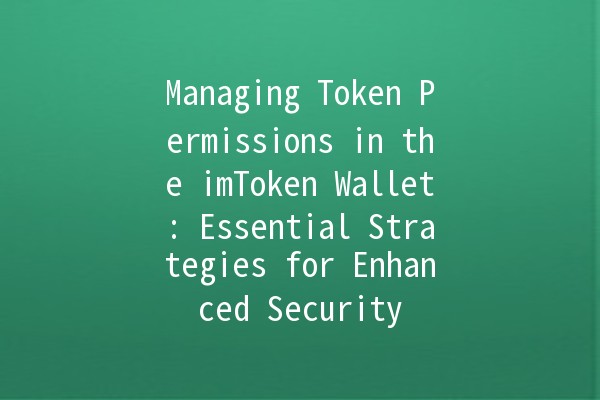The imToken wallet is a popular digital asset management tool that allows users to store, manage, and trade various cryptocurrencies. One essential aspect of using this wallet effectively is understanding and managing token permissions. Token permissions determine what actions can be taken with the tokens you hold. This article delves deep into the settings of token permissions in the imToken wallet, offering practical tips and strategies for users to enhance their security and usability.

Token permissions are critical in ensuring that your transactions and holdings are secure. By managing these permissions, you can control how your tokens interact with different decentralized applications (dApps). If not properly configured, you risk exposing yourself to unauthorized transactions or unnecessary losses. Therefore, understanding and setting the right permissions is key to a secure asset management experience.
Here are several actionable tips to optimize your token permissions in the imToken wallet:
When connecting your wallet to any dApp, provide only the necessary permissions. Avoid granting all permissions indiscriminately, as this could lead to potential losses or unauthorized access to your tokens.
Application Example: For instance, if you are using a DeFi platform to stake tokens, only allow the necessary permissions for the staking operation. This usually includes allowing the dApp to view your token balance, not to transfer it.
It is essential to periodically review the permissions you’ve granted to various dApps. Sometimes, you may find that you have granted excessive permissions to dApps you no longer use.
Application Example: Check your permission settings in imToken every few months. If you find applications that you have not interacted with recently, revoke their access.
While not directly related to token permissions, enabling 2FA adds an extra layer of security, particularly when accessing your wallet or making significant transactions.
Application Example: Use applications like Google Authenticator or Authy to set up 2FA for your imToken wallet. This way, even if someone gains access to your wallet, they would still need the 2FA code to make any changes or transactions.
Understanding what each dApp does helps you make informed decisions regarding which permissions to grant. This knowledge enables you to assess the risks associated with connecting your wallet to specific dApps.
Application Example: Before linking your wallet to a new DeFi project, research its background, read reviews, and check community feedback to ensure it is trustworthy.
Some wallets and platforms allow you to set limits on the number of tokens that can be spent or transferred over a specific period. This feature can add a level of security against unauthorized access.
Application Example: If you frequently trade small amounts, set a limit that protects your larger holdings from being transferred without your consent. For example, only allow a dApp to manage 100 tokens at a time.
While managing token permissions can enhance security, users often face challenges. Here are some common issues and solutions:
Many users find the technical jargon surrounding permissions confusing. It's crucial to simplify these concepts.
Solution: Look for educational resources directly from imToken or cryptocurrency education platforms to help clarify terms and permissions in layman’s terms.
Sometimes, a dApp that was once deemed trustworthy may experience a security breach.
Solution: Remain vigilant and subscribe to alerts from securityfocused sites or communities to stay updated about potential breaches related to the dApps you are using.
New users often overlook the importance of adjusting permissions when connecting to dApps.
Solution: Slide tutorials or tips within the imToken app could guide users through the initial setup and emphasize the significance of managing token permissions proactively.
In addition to the strategies discussed, here are some best practices to consider:
Token permissions determine the level of access a dApp has to your tokens. They dictate what actions can be performed with your tokens, such as transferring or viewing your token balance.
You can manage token permissions within the imToken app by navigating to the dApps section and reviewing the permissions granted to each connected application. Here, you can revoke permissions as needed.
If you suspect that a dApp has compromised your tokens, immediately revoke its permissions, withdraw your tokens, and consider changing your wallet password.
Yes, granting excessive permissions can lead to unauthorized transactions and potential losses. It’s advisable to only provide the minimum required permissions.
It’s recommended to review your token permissions at least every few months or immediately after using a new dApp. Regular checks help you maintain control over your assets.
Yes, you can reset permissions by revoking access for specific dApps or by managing settings in your imToken wallet’s security section.
By understanding and managing token permissions effectively, you can significantly enhance the security of your digital assets in the imToken wallet. Implementing the strategies outlined above will help you maintain better control of your holdings and protect against unauthorized access.